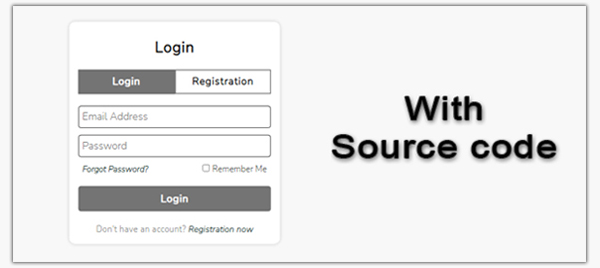HTML CSS Login Form template with source code
Last Updated: 2024-02-24 22:53:17
A login form is a user interface element that allows a user to enter their credentials (such as a username and password) to authenticate themselves and access a system or application. Login forms are commonly used on websites and applications to protect restricted content or features.
In web development, login forms are typically designed using HTML and CSS, and may also include JavaScript for additional functionality such as form validation and integration with a backend system for authentication.
A login form typically consists of a form element that contains one or more input fields for the user to enter their credentials, and a submit button that the user can click to send their credentials to the server for verification. The form may also include additional elements such as checkboxes, dropdown lists, and buttons for password recovery or social media login options. Please download the main source code of the Login form.
The design of a login form is important because it affects the user experience and can influence the user's decision to sign up for or use an application or system. A well-designed login form should be easy to use, visually appealing, and accessible to users with disabilities. Remember before the login form you need to design a registration form also.
👉👉 Five Login Registration Form Example 👈👈
- Login Registration Template With Google And Facebook Buttons
- Login Registration Template With Password Show Hide Feature
- Toggle Login And Registration Form In HTML CSS And JavaScript
- Login Page Template Design With Particle JS Animation
- HTML CSS Login Page Template With Animated Label And Submit Button
Here is an example of how you can design a login form using HTML and CSS:
< !DOCTYPE html>
< html>
< head>
< style>
/* Style the form elements */
form {
width: 300px;
margin: 0 auto;
text-align: center;
}
input[type="text"], input[type="password"] {
width: 100%;
padding: 12px 20px;
margin: 8px 0;
box-sizing: border-box;
border: 2px solid #ccc;
border-radius: 4px;
}
button[type="submit"] {
width: 100%;
background-color: #4CAF50;
color: white;
padding: 14px 20px;
margin: 8px 0;
border: none;
border-radius: 4px;
cursor: pointer;
}
button[type="submit"]:hover {
background-color: #45a049;
}
/* Style the error message */
.error {
color: red;
}
< /style>
< /head>
< body>
< !-- Create the form -->
< form method="post" action="login.php">
< label for="username">Username:< br>
< input type="text" id="username" name="username">< br>
< label for="password">Password:< br>
< input type="password" id="password" name="password">< br>< br>
< button type="submit">Login
< /form>
< /body>
< /html>
Please download the main source code of the Login form.
This code creates a simple login form with two text fields for the username and password, and a submit button. The form elements are styled using CSS, and the form is centered on the page using the margin: 0 auto property.
The form element has a method attribute that specifies the HTTP method (in this case, "post") used to submit the form data to the server, and an action attribute that specifies the URL of the server-side script that will process the form data.
The label elements are used to give the form fields descriptive names, and the attribute of the label elements is linked to the id attribute of the corresponding form field using the same value. This allows users to click on the label to focus on the form field.
The input elements are used to create the form fields, and the type attribute specifies the type of field (in this case, "text" for the username and "password" for the password). The name attribute specifies the name of the field, which is used to identify the form data when it is submitted to the server.
The button element is used to create the submit button, and the type attribute specifies the type of button (in this case, "submit"). The value attribute specifies the text that will be displayed on the button.
Best practice for login form design
Here are some best practices for designing a login form:
Keep it simple: Use a minimal design and only include the necessary form fields and buttons.
Use clear and descriptive labels: Use clear and descriptive labels for the form fields to help users understand what information is required.
Use visual hierarchy: Use design elements such as size, color, and spacing to create a visual hierarchy and draw the user's attention to the most important elements.
Make it mobile-friendly: Ensure that the login form is responsive and works well on mobile devices.
Use appropriate error messages: Use clear and helpful error messages to inform the user if their login attempt was unsuccessful and provide guidance on how to fix any issues.
Use appropriate colors: Use colors that are appropriate for the brand and easy on the eyes. Avoid using colors that are too bright or hard to read.
Use appropriate font sizes: Use font sizes that are easy to read and appropriate for the context. Avoid using font sizes that are too small or too large.
Use appropriate font styles: Use font styles that are easy to read and appropriate for the context. Avoid using fancy or decorative fonts that are hard to read.
By following these best practices, you can create a login form that is easy to use, visually appealing, and accessible to users with disabilities.
Learn how to ensure security in the login form.
Here are some common features that may be included in a login form
1. Text fields for the user to enter their username and password
2. A submit button to send the login request to the server
3. A "forgot password" or "reset password" link to allow users to reset their password if they have forgotten it
4. A checkbox to allow users to stay logged in or save their login credentials
5. A "create account" or "sign up" link to allow new users to create an account
6. A link to the login using a social media account (such as Facebook or Google)
7. A CAPTCHA field to verify that the user is a human and not a bot trying to automate the login process
8. Error messages to inform the user if their login attempt was unsuccessful and provide guidance on how to fix any issues
9. A "remember me" function to remember the user's login credentials on their device
Please download the main source code of the Login form. You can also download the registration form.
These are just a few examples of the features that may be included in a login form. The specific features will depend on the requirements and goals of the application or system.
Still you face problems, feel free to contact with me, I will try my best to help you.

